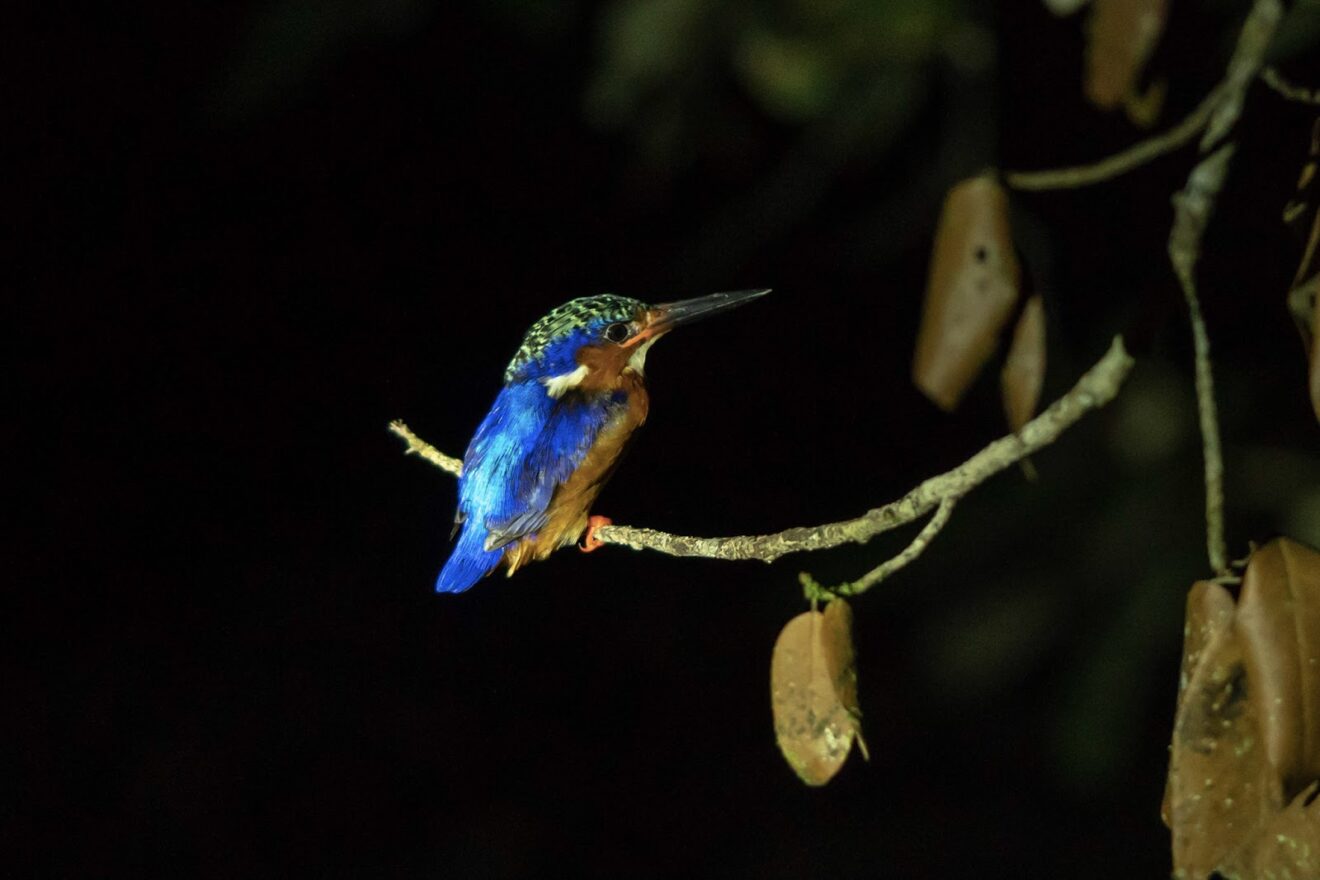
Masoala National Park is located in the northeastern part of Madagascar and is over 2.300 square kilometers. It is listed as a UNESCO World Heritage site and is the largest national park in Madagascar. In addition to the park there are also over 100 square km of protected marine waters in front of the park and is home to coral reefs and a very diverse marine life with humpback whales as their most spectacular inhabitants.
Masoala means ‘eyes of the forest’ in Malgache and comes from the aye-aye’s glowing eyes which light up in the dark of the forest. The aye-aye is one of the many lemur species which can be found in Masoala. At least 94 of Madagascar’s 283 resident birds have been sighted at Masoala. Besides birds of prey, other highlights are the ground-dwelling and elusive red-breasted coua and ground rollers, the pygmy kingfishers (which feeds insects instead of fish) and the helmet vanga, whose huge bill resembles the toucan’s or hornbill’s.
For its size, Madagascar has a relatively short bird list, yet it is home to at least 37 endemic genera, more than any other African country. It is the quality rather than the quality which attracts birders from all around the world. There are an estimated 109 endemic species, which includes five endemic families. Most of these are dependent on the forest or wetlands. In the open highlands and urban centers the variety is way less. Madagascar shares 13 species with the Comoros and 7 with the Seychelles. Many of these belong to genera confined to the islands of the western Indian Ocean such as the vasa parrots, blue pigeons and fodies. Those species present in Madagascar are more plentiful than members of the same genera on the other islands. Among these are the greater and lesser vasa parrots, Madagascar blue pigeon and gaudy Madagascar red fody.




To the uninitiated, Madagascar’s black vasa parrots (coracopsis sp) hardly merti a second glance, but the breeding behavior of these birds is fascinating. Unlike monogamous parrots elsewhere, greater vasa parrots are highly promiscuous, with the females taking the initiative in courtship. Although smallers, the males have risen to the challenge by evolving a large phallus for copulation sessions that can last two hours. Females in breeding condition lose their head feathers and the bald skin turns orange-yellow. They have singing perches adjacent to their tree-cavity nests and it is the case of she who sings loudest attracts the most males (who are then responsible for supplying the food). During the chick-rearing phase females spend up to 60 percent of their time singing (or screeching).
The vangas are the most celebrated endemic bird family in Madagascar. Vangas fill niches that are occupied in other parts of the world by woodpeckers, wood-hoopies, shrikes, tits, treecreepers and nuthatches, all of which are absent from Madagascar. Most vangas are gregarious and are often seen in mixed-species feeding flocks.
The various forms of vanga beaks reflect the size of each species’ preferred prey, its location and mode of capture. Larger, shrike-like species, such as the hook-billed vanga, have robus beaks with a characteristic hook at the trip to help them deal with sizeable insects and small invertebrates. The extraordinary helmet vanga is known to feed on small chameleons, frogs, insects, small centipedes and even the occasional scorpion.

Masoala Birding And Bird Photography Expeditions
Masoalo is a great place for birding as you will see a lot of really unique species in an absolutely stunning environment. For those interested in a complete experience away from the lodges where you will go deep into the forest to photograph and ID birds and other animals, we can set up an expedition for you and your team.
As there are no hiking trails or accommodation available, this is done through camping. For these expeditions a special permit is needed from the park authorities. Your group will be assisted by a team of national park guides, porters and a cooking team.
It takes two days to go to Maroantsetra overland or it is possible to charter a plane. We will typically spend one – two days at Maroantsetra making sure all the paperwork is in order and all the gear is loaded up and everyone is briefed and prepped.
Please, send us an email with your enquiry, group size, project and also the desired duration you would like to stay at the forest and we will come back to you with a proposition and quote as soon as possible. Serious requests only, please.
Masoala has around 90 listed species of birds. Below is a partial bird list for Masoala National park. Source: www.wildmadagascar.com
Accipiter francesii: Frances’ Goshawk
Accipiter henstii: Henst’s Goshawk
Accipiter madagascariensis: Sparrowhawk fo Madagascar
Agapornis cana: Madagascar Lovebird
Alcedo vintsioides: Malagasy Kingfisher
Alectronenas madagascariensis: Madagascar Blue Pidgeon
Ardea humbloti
Ardea purpurea madagascariensis
Asio madagascariensis: Marsh Owl
Atelornis crossleyi: Rufous-headed Ground-Roller
Ateornis pittoides: Pitte-like Ground-Roller
Brachypteracias leptosomus: Short-legged Ground-Roller
Brachypteracias squamiger
Bubulcus ibis: Cattle Egret
Buteo brachypterus: Madagascar Buzzar
Butorides striatus
Calicalicus madagascariensis: Red-tailed Vanga
Canirallus kioloides: Madagascar Wood Rail
Caprimulgus enarratus: Collared Nightjar
Centropus toulou: Madagascar Coucal
Cisticola cherina: Madagascar Cisticola
Copsychus albospecularis: Madagascar Magpie-Robin
Coracina cinerea: Ashy Cuckoo-Shrike
Cisticola cherina: Madagascar Cisticola
Copsychus albospecularis: Madagascar Magpie-Robin
Coracina cinerea: Ashy Cuckoo-Shrike
Coracopsis nigra: Lesser Vasa Parrot
Coracopsis vasa: Greater Vasa Parrot
Corvus albus: Pied Crow
Coua caerulea: Blue Coua
Coua reynaudii: Red-fronted Coua
Coua serriana: Red-breasted Coua
Cuculus rochii: Thick-billed Cuckoo
Cyanolanius madagascarinus: Blue Vanga
Dicrurus forficatus: Crested Drongo
Dryolimnas cuvieri: White-throated Rail
Euryceros prevostii: Helmet Vanga
Eurystomus glaucurus: Broad-billed Roller
Eutriorchis astur: Madagascar Serpent-Eagle
Falco newtoni: Madagascar kestrel
Foudia madagascariensis: Madagascar Red Fody
Foudia omissa: Forest Fody
Glareola ocularis: Madagascar Pratincole Hartlaubius auratus: Madagascar Starling
Hypositta corallirostris: Nuthatch Vanga
Hypsipetes madagascariensis: Bulbul
Ispidina madagascariensis: Madagascar Pygmy Kingfisher
Leptopterus chaber: Charbert’s Vanga
Leptopterus viridis: White-headed Vanga
Leptosomus discolor: Cuckoo Roller
Lonchura nana: Madagascar Mannikin
Lophotibis cristata: Madagascar crested ibis
Merops superciliosus: Madagascar bee-eater
Mesitornis unicolor: Brown Mesite
Milvus migrans: Black Kite
Motacilla flaviventris: Madagascar Wagtail
Mystacornis crossleyi: Crossley’s Babbler
Nectarinia notata: Long-billed green sunbird
Nectarinia souimanga: Souimanga Sunbird
Neodrepanis coruscans: Sunbird-Asity
Neomixis striatigula: Stripe-throated jery
Neomixi tenella: Common Jery
Nesillas typica: Madagascar Brush-Warbler
Newtonia amphicroa: Dark Newtonia
Newtonia brunneicauda: Common Newtonia
Ninox superciliaris: White-browed boobook
Numida meleagris: Helmeted Guineafowl
Oriolia bernieri: Bernier’s Vanga
Otus rutilus: Malagasy Scops-Owl
Oxylabes madagascariensis: White-throated Oxylabes
Philepitta castanea: Velvet Asity
Phyllastrephus cinereiceps: Grey-crowned Greenbul
Phyllastrephus madagascariensis: Long-billed Greenbul
Phyllastrephus zosterops: Spectacled Greenbul
Ploceus nelicourvi: Nelicourvi Weaver
Polyboroides radiatus: Madagascar Harrier-Hawk
Pseudobias wardi: Ward’s Shrike-Flycatcher
Pseudocossyphus sharpei: Forest Rock-Thrush
Randia pseudozosterops: Rand’s warbler
Schetba rufa: Rufous Vanga
Streptopelia picturata: Madagascar Turtledove
Tersipphone mutata: Madagascar Paradise Flycatcher
Trero australis: Madagascar Green Pigeon
Turnix nigricollis: Madagascar Buttonquail
Tylas eduardi: Tylas Vanga
Vanga curvirostris: Hook-billed Vanga
Zoonavena grandidieri: Madagascar Spine-tailed Swift
Zosterops maderaspatana: Madagascar White-Eye













